Pallet jack wheels facilitate the smooth movement of heavy loads. They come in various types and materials to suit different applications and environments. Commonly, a pallet jack has two types of wheels - load and steer wheels. A steering wheel is located at the back side of the pallet jack and allows the operator to control the direction of movement. While the load wheel is located under the pallet jack's forks and supports the load's weight.
In this article, you’ll learn:
- Purpose and Use of Pallet Jack Wheels
- Types: Load and Steer Wheels
- Standard Sizes Available in the Market
- Commonly Used Materials for Pallet Jack Wheels
- What Includes in a Pallet Jack Wheel Repair Kit?
- Why Should You Consider Us, Pallet Jackson, for Buying Pallet Jack Wheels?
Pallet Jack Wheels - An Overview of Functionalities
Pallet jack wheels enable smooth maneuverability of heavy loads on different surfaces, such as concrete, wood, or metal. These wheels are usually made of polyurethane, nylon, or rubber and can vary in size, shape, and design. Pallet jack wheels have different functions depending on their location on the pallet jack.
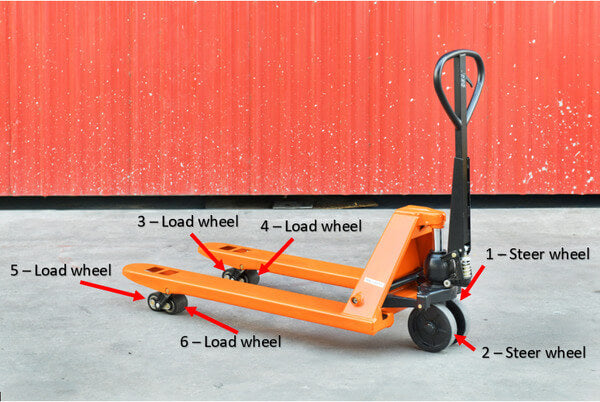
The steer wheels are the ones attached to the handle and used to steer and maneuver the pallet jack. The load wheels are located under the forks and used to support and lift the pallets.
Let’s discuss them in detail.
Types of Pallet Jack Wheels
1. Load Wheels (Front Wheels)
Load wheels bear the entire weight of pallets and cargo. They are strategically positioned at the front to provide a stable base and evenly distribute the load across multiple contact points. This prevents any uneven weight distribution that could lead to instability or damage. Load wheels are smaller in diameter than steer wheels on the pallet jack. The load wheels are usually made of steel, polyurethane, or rubber and have bearings to reduce friction.
2. Steer Wheels (Rear Wheels)
The steer wheels are located at the back and controlled by the pallet jack handle. These wheels have swivel casters for free rotation and smooth directional changes. They also have swivel locks or brakes for added stability during long-distance travel or when navigating uneven terrain. The most common material used for the steer wheels is polyurethane. Nylon, rubber, and steel are other materials that are sometimes used for the steer wheels.
Commonly Used Materials for Pallet Jack Wheels
The choice of material for the wheels depends on the type of floor, the weight of the load, the noise level, and the durability.
Some of the most commonly used materials for pallet jack wheels are:
1. Polyurethane and Ultra-Polyurethane
Polyurethane is one of the most widely used materials for pallet jack wheels. These synthetic materials offer a good balance of durability, traction, and noise reduction. They resist abrasion, chemicals, and water and can handle various floor conditions. Ultra-polyurethane is a harder version of polyurethane, providing more load capacity, less rolling, and chemical resistance.
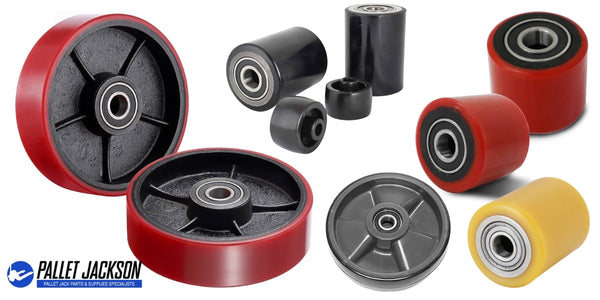
2. Rubber
This is a natural material that provides a smooth and quiet ride. It is suitable for delicate or uneven floors, as it can absorb shocks and vibrations. However, rubber wheels are prone to wear and tear and may perform poorly in extreme temperatures or wet environments.
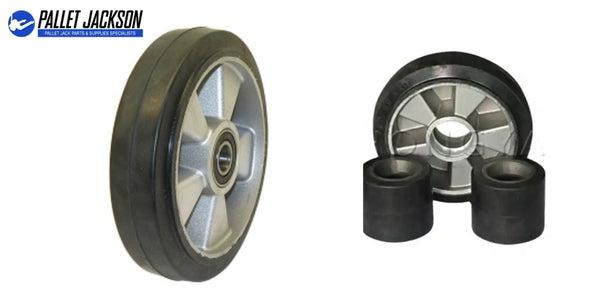
3. Steel
This is a metal material that provides high strength and durability. It is ideal for heavy-duty applications, as it can withstand high loads and impacts. Steel wheels are also resistant to corrosion, chemicals, and heat. However, steel wheels are noisy, hard, and may damage the floor surface.
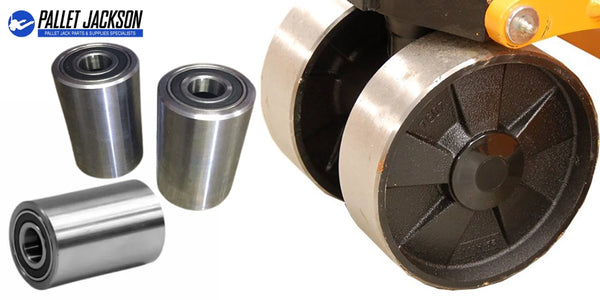
4. Nylon
This is a plastic material that is lightweight and low-cost. It can roll easily and smoothly on hard, flat floors, such as wood or laminate. It can also resist impact, abrasion, and chemicals. However, nylon can be slippery and noisy and may not provide enough traction or cushioning.
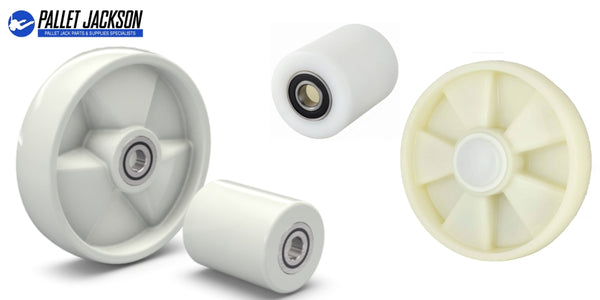
5. Cast Iron, Aluminum, Rubber-coated Steel
These are other metal materials that are sometimes used for pallet jack wheels. Cast iron is similar to steel but heavier and more brittle. Aluminum is lighter than steel but less durable. Rubber-coated steel is a combination of steel and rubber that offers some advantages of both materials.
What Includes in a Pallet Jack Wheel Repair Kit?
A pallet jack wheel repair kit is a set of tools and parts to help you fix a damaged or worn-out pallet jack wheel.
The kit usually includes the following items:
Replacement Wheels
The core component of a wheel repair kit is the replacement wheels themselves. These kits typically include either a set of two wheels or four wheels. The replacement wheels are designed to match the original specifications, ensuring compatibility and seamless integration with the pallet jack.
Bearings
These metal rings fit inside the wheels and allow them to rotate smoothly. Bearings reduce friction and noise and increase the lifespan of the wheels. They also come in different types and sizes depending on the pallet jack model.
Washers
These thin metal discs go between the bearings and the fasteners. Washers help to distribute the load and prevent damage to the bearings and the wheels. Depending on the pallet jack model, they also come in different sizes and shapes.
Fasteners
These are the screws, nuts, bolts, or pins that secure the wheels to the pallet jack. Fasteners ensure that the wheels are firmly attached and aligned. Depending on the pallet jack model, they also come in different sizes and shapes.
Spacers
These metal tubes or rings create a gap between the wheel and the fork. They help prevent rubbing and ensure proper alignment of the wheel.
Bushings
These metal or plastic sleeves fit inside the wheel hub or on the axle. They help reduce wear and tear and improve the stability of the wheel.
Axles
These are the metal rods that connect the wheels to the forks. They support the weight of the load and allow the wheels to rotate.
Others
Depending on the type and model of your pallet jack, you may need other parts or tools to complete the wheel repair. For example, you may need a wrench, a hammer, a pry bar, a grease gun, or a lubricant. You should check your pallet jack manual or contact your manufacturer.
Choose Pallet Jackson to Buy Pallet Jack Wheel Replacement
If you need to buy pallet jack wheel replacement, choose Pallet Jackson as your supplier. Pallet Jackson has been a reputable company in the industry for over a decade. We offer high-quality products at competitive prices and a fast and reliable delivery service. Pallet Jackson also has a friendly and knowledgeable customer support team to help you with any questions or issues. Whether you need to replace one wheel or a whole set, Pallet Jackson has the right solution. Don't settle for low-quality or overpriced pallet jack wheels. Choose Pallet Jackson and get the best value for your money.Your Search


































































































